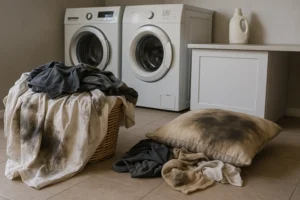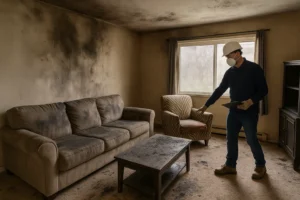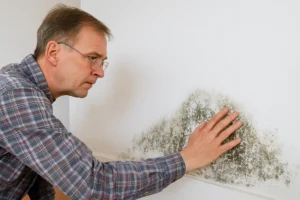After a fire, or even from nearby smoke exposure, one of the most frustrating problems homeowners face is the lingering smell and stains in clothes, bedding, curtains, and upholstered furniture. It’s not just about the odor—smoke can leave behind tiny particles of soot, chemicals, and toxins that cling deep into fabric fibers.
If you’re asking yourself, “How do I clean clothes and fabric after smoke exposure?”, you’re not alone.
This guide will walk you through:
- How different fabrics respond to smoke damage
- Effective cleaning methods for various materials
- Pros and cons of DIY cleaning vs. professional help
- How to know when to call in experts like Tradewinds Restoration
- And what steps you can take right now to protect your health and your belongings
Why Smoke-Damaged Fabrics Are So Tricky
Smoke isn’t just a smell—it’s made of tiny particles of soot, ash, and chemicals that embed themselves into fabrics. These particles can cause:
- Lingering odors
- Skin irritation or allergic reactions
- Discoloration and stains
- Fabric weakening over time
The challenge is that not all fabrics react the same way. Delicate items like silk or wool can react differently than heavy materials like denim or canvas. That’s why it’s important to know the right cleaning method for each fabric.
How to Clean Clothes and Fabrics After Smoke
Cotton and Linen
These are natural fabrics made from plants. They are used for clothes, sheets, and some things in your house.
- How they act with smoke: They can soak up smoke and smells easily because they have tiny holes. But they are also strong and can handle more washing.
- Problems: Hot water can make them shrink, especially linen. They can also get stained by smoke if you don’t clean them fast.
How to clean them:
- Sort: Put white and light clothes in one pile and dark clothes in another.
- Pre-treat: If some spots are really dirty, soak them in cool water with a little bit of gentle soap or a special cleaner for smoke smell.
- Wash: If the tag on the clothes says it’s okay, wash them in hot water. Hot water helps get rid of smoke and oily stuff. Use a strong laundry soap that fights bad smells. You can also add a special powder for smells or one cup of baking soda. You might need to wash them more than once if they smell really smoky.
- Dry: If the tag says it’s okay, you can dry cotton in a hot dryer, which can help with the smell. But be careful with linen, it might shrink. It’s often better to hang them up to dry. This way, you can check if they still smell smoky before you dry them with heat.
- Check: Before they are totally dry, smell them. If they still smell like smoke, wash them again.
Wool
Wool comes from animals like sheep. It’s warm and soft and used for sweaters and blankets.
- How it acts with smoke: Wool can trap smoke and smells inside its fibers. But it’s also delicate and can get ruined easily.
- Problems: Hot water, lots of shaking, and strong soaps can make wool shrink, get stiff, or break.
How to clean it:
- First steps: Take the wool item outside and gently shake it or brush it to get rid of loose black stuff. Letting it air out in a breezy place (but not in the sun) can also help a little.
- Wash by hand: Fill a sink with cool water and add a tiny bit of soap made for wool or gentle clothes. Gently put the wool item in the water and don’t rub or twist it hard. Let it soak for a little while, then rinse it with cool water until all the soap is gone.
- Dry: Gently squeeze out extra water (don’t twist!). Lay it flat on a clean, dry towel and roll the towel up to soak up more water. Then, unroll it and lay the wool item flat on a drying rack or clean surface to dry on its own. Keep it away from heat and sunlight. Don’t hang wool because it can stretch.
- Ask a professional: If your wool item is very smoky or you’re not sure how to wash it, take it to a dry cleaner. Tell them it was around smoke so they can clean it the right way.
Silk
Silk is a fancy fabric that feels smooth and shiny. It’s used for nice clothes and scarves.
- How it acts with smoke: Silk can easily soak up smoke smells. But it’s also very easy to damage when cleaning.
- Problems: Water can leave marks on silk that won’t go away, and heat can make it lose its shine and get weak.
How to clean it:
- Don’t use a washing machine: It will likely ruin silk.
- Clean spots carefully (maybe): If there’s just a little bit of smoke, you can try to clean the spot with a very mild soap mixed with cool water. Test it on a hidden part of the silk first. Use a soft cloth to gently pat the spot, moving from the outside in. Don’t rub. Pat it dry with a clean, dry cloth.
- Get a professional: It’s best to take smoky silk items to a dry cleaner who knows how to clean delicate fabrics. Tell them about the smoke. They have special ways to get smells out of silk.
Synthetic Fabrics (like Polyester, Nylon, Spandex)
These are man-made fabrics that are strong and don’t shrink easily. They are used for things like sports clothes and jackets.
- How they act with smoke: They don’t soak up smoke as much as natural fabrics, so the smell usually stays on the surface.
- Problems: Very high heat can make these fabrics melt or change shape.
How to clean them:
These are often made of thick fabrics and might have soft stuff like foam inside.
- How they act with smoke: The outside fabric might block a little smoke, but the soft stuff inside can really soak up smoke and smells, making them hard to clean.
- Problems: Washing them the wrong way can damage the fabric, make them shrink, or leave water marks.
Furniture Covers and Curtains
These are man-made fabrics that are strong and don’t shrink easily. They are used for things like sports clothes and jackets.
- How they act with smoke: They don’t soak up smoke as much as natural fabrics, so the smell usually stays on the surface.
- Problems: Very high heat can make these fabrics melt or change shape.
How to clean them:
- Vacuum first: Use a vacuum cleaner with a special filter to clean all the surfaces of your furniture and curtains. Pay extra attention to folds and corners where smoke stuff can get stuck.
- Smell removers: Use sprays made for fabrics that get rid of smoke or pet smells. Read the directions carefully and try it on a hidden spot first to make sure it doesn’t stain.
- Ask a professional: If the smoke smell won’t go away or there’s a lot of smoke, it’s best to get your furniture covers professionally cleaned. For curtains, you might need to get them dry cleaned. These cleaners have special tools and soaps to get rid of smoke without ruining your things.
- Ozone treatment: If the smoke damage is really bad, professionals can use a special gas called ozone to get rid of the smell. But only trained people should do this, and you can’t be in the room when they do it.
- Dry clean curtains: Many curtains, especially fancy ones, should be dry cleaned to avoid shrinking or getting damaged. Tell the dry cleaner about the smoke.
By knowing what kind of fabric you have and using the right cleaning methods, you have a better chance of getting smoke smells and stuff off your clothes and things in your house. Always check the tag for cleaning instructions, and if you’re not sure what to do, ask a professional cleaner for help.
DIY Cleaning Methods: Can You Handle Smoke-Damaged Fabrics Yourself?
Washing Clothes at Home
For minor smoke exposure:
- Shake out the fabric outdoors to remove loose soot.
- Pre-soak in warm water with one cup of baking soda for at least one hour.
- Wash separately using heavy-duty detergent and a cup of white vinegar.
- Repeat washes as needed—smoke particles are stubborn.
- Air dry outside if possible, as heat from dryers can lock in odors.
Cleaning Upholstery and Curtains
Vacuum surfaces with a HEPA filter to capture smoke particles. Lightly mist with a solution of water and vinegar (test a small area first). If the smell persists, you may need professional smoke deodorization.
Pros and Cons of DIY Cleaning
Pros | Cons |
Lower cost | May not remove deep-set odors or toxins |
Quick to start | Risk of setting odors/stains if done incorrectly |
Works for lightly exposed items | Time-consuming; may need multiple washes |
Good for non-porous items like denim | Delicate fabrics may be damaged by home methods |
When Should You Call a Professional?
If you’ve tried washing your clothes or cleaning fabrics and the smoke smell still lingers, it’s time for professional help.
Call in the pros when:
- The smoke smell persists after multiple washes
- Fabrics feel brittle, discolored, or stained
- Items have sentimental or high-dollar value
- You’re dealing with large quantities of affected items
- You or your family experience allergy symptoms when using the items
At Tradewinds Restoration, we offer specialized cleaning and deodorizing services that go beyond what regular laundry can handle. Our Fire Damage Restoration process includes pack-out services for textiles and soft goods, advanced ozone or hydroxyl treatments, and expert assessments to determine what’s safe to keep.
Health Risks of Keeping Smoke-Exposed Fabrics
Even if an item looks clean, smoke residue can contain harmful chemicals like formaldehyde, benzene, and carbon monoxide. These can trigger:
- Coughing or breathing issues
- Headaches or dizziness
- Skin irritation
- Aggravation of asthma or allergies
If you’re unsure whether an item is safe to use, it’s always best to err on the side of caution — and contact us for a professional opinion.
Can Insurance Help Cover the Costs?
Yes, many homeowners’ insurance policies cover:
- Cleaning and deodorizing services for smoke-exposed fabrics
- Replacement costs for unsalvageable items
- Pack-out and storage services during restoration
Our team at Tradewinds Restoration works directly with insurance adjusters to document damage, provide estimates, and help you navigate the claims process.
Tips for Protecting Fabrics After a Fire
✔ Remove items from the smoky environment as soon as it’s safe.
✔ Avoid using your HVAC system until it’s inspected—smoke can spread through ducts.
✔ Don’t try to “air out” fabrics inside; take them outside to ventilate.
✔ Keep smoke-exposed items separate from clean ones to avoid cross-contamination.
Don’t Let Smoke Damage Linger
Cleaning clothes and fabric after smoke exposure is about more than getting rid of a bad smell—it’s about protecting your health, your comfort, and your investment.
For small items, DIY methods can help. But for large quantities, delicate fabrics, or lingering odors, professional cleaning is the safest and most effective choice.
At Tradewinds Restoration, we’re here to help you:
- Assess what can be saved and what should be replaced
- Clean, deodorize, and restore fabrics with care
- Work with your insurance for a smoother claims process
Contact us today to schedule a fire damage assessment and get your home—and your belongings—back to normal.






